Enlarge image
Hyundai Staria
Photo: Thorsten Weigl / Hyundai
Development stop, end of sales, system change - in 2021 the car bosses consistently outbid each other with their announcements about the end of the internal combustion engine.
This year they apparently want to prove that they mean business.
The list of the most important new cars for 2022 suggests: The days for petrol and diesel are actually numbered.
The number of electrical innovations appears to be larger again; the majority will have a socket in 2022.
The charging infrastructure is still lagging behind.
Yes, there are still a few new combustion engines and some of them deserve attention - like the Opel Astra, the BMW 7 Series, the new Mercedes E-Class or the first SUV from Ferrari.
In the past, specialist magazines would have dedicated the front page to such cars.
But the PS industry has long been electric.
It is not just new models that are supposed to advance the drive turnaround, but also brands that have so far been little known, at least in Germany.
In the USA, China and even Vietnam, new electric vehicles are about to be launched and will come to Europe in 2022.
Fuel cell technology is also getting some tailwind again.
The first small vans with hydrogen as an energy source are entering the private customer business.
The times when Honda, Toyota and Hyundai were among themselves in this segment and were ridiculed for their commitment are probably over.
The PS industry is changing like never before since its inception, the next revolution is already imminent with autonomous driving.
The German market in particular was hit particularly hard by Corona and the chip crisis.
Autoboom and no end in sight
But the carmakers apparently have little to worry about: »Everyday life is unimaginable without the car.
And it continued to gain in importance in the course of 2021, ”says automotive economist Ferdinand Dudenhöffer from the Center Automotive Research in Duisburg.
"According to our extrapolation, the number of cars in Germany increased again in 2021 and stood at 48.7 million cars at the turn of the year. That is a good 400,000 more than a year ago." Were in short supply.
"With the electric car and the trend towards mobile homes, the car will continue to grow in popularity in the new year," says the car expert.
This is also because, on average, car buyers are getting younger again.
“By 2015 a kind of Methuselah effect had set in.
The average age of new car buyers rose continuously to a maximum of 52.7 years. «Since then, the increase has stopped.
So there are increasingly new groups of buyers for new cars.
Here are the most important models for 2022 that run on electricity:
Nio ET5
After
Nio is
already one of the big
names
in China and has brought the first cars to Europe via Norway, the manufacturer also wants to gain a foothold in Germany in 2022.
The all-electric fleet differs from Tesla and Co. primarily in the principle of automated battery change at charging stations along the highways.
The fleet previously consisted of the ES6 and ES8 SUVs and the ET7 sedan.
But shortly before the turn of the year, Nio
presented its perhaps most promising export
candidate, the
ET5
.
Designed as an alternative to Tesla's Model 3, the five-seater with a rental battery is said to start for less than 40,000 euros and allow a range of more than 1000 kilometers with a 150 kWh battery.
Smart SUV
With Chinese technology, German design and a completely new concept,
Smart is
daring a
new beginning this year.
The tiny city runabouts ForTwo and ForFour will soon be history.
With an
SUV
in the format of the Mini Countryman, the tiny one grows beyond itself.
Some fans will mourn, but the new concept has one advantage: larger batteries fit into the ground, with which the smart drivers no longer have to plug in every 150 kilometers.
Toyota bZ4X
For a long time fixated on the hybrid drive,
Toyota
only started its big electric offensive at the end of the year.
The first Stromer
bZ4X
should be on the road this year.
Like so many cars drawn as SUVs, the competitor of the VW ID.4 with a battery of around 70 kWh promises a range of up to 450 kilometers and will probably cost around 45,000 euros.
Mercedes EQT
Mercedes is also
making electromobility a family affair this summer - and is probably the cheapest electric car with the star, bringing the
EQT
to the charging station.
The small van with up to seven seats and initially a modest 285 kilometers range from a 44 kWh battery is not a purely in-house development.
Just like the Citan and the T-Class, also announced for 2022, it is based on the Renault Kangoo, which will also be available as an electric car this year.
Renault Megane E-Tech
With the Zoe,
Renault was
at the forefront of the electric revolution - and then somehow lost the thread.
The French take it up
again
with the
Megane E-Tech
.
As a challenger for the VW ID.3, the compact five-door is the first model on a new e-platform and the forerunner of a fleet of battery-powered cars.
Equipped with up to 60 kWh for a range of a maximum of 470 kilometers, with a lot of smart technology but without an SUV design, it should come onto the market in the summer and cost 35,200 euros (in the weaker basic version).
Lucid Air
Tesla Model S or Mercedes EQS?
So far, the selection in the electric luxury class has been modest.
But at least a third alternative from the USA will enter the race in 2022.
The
Lucid Air
.
Developed by former Tesla chief engineer Peter Rawlinson and drawn as a passionate limousine, the luxury liner is already available on the other side of the Atlantic - for the equivalent of around 140,000 euros with 1000 hp engines and 113 kWh of battery capacity for a range of more than 800 kilometers.
An entry-level model has also been announced for around 60,000 euros.
Lucid has not yet revealed which configurations will be exported.
Mercedes EQE
The EQS is getting a smaller brother: This year Mercedes is building
an
EQE
on the same platform
- more soberly drawn and intended for company drivers at an estimated price of 75,000 euros or more, it starts with the smaller EQS battery and then comes with the 90 kWh up to 660 Miles away.
It starts with an EQE 350, whose rear-wheel drive has an output of 215 kW.
Versions with two engines and all-wheel drive are to follow later.
VW ID.Buzz
With the new
ID.Buzz
,
VW
wants to get
the hippies of
yore
excited about electromobility and, by the way, all other Bulli fans and parents.
The electric MPV was a star at many trade fairs as a show car, but is a bit more sober in the series version.
What remains is the technology from the MEB, which the ID.Buzz shares with cars such as the ID.3 or the ID.4 - which stands for up to 300 kW drive power and batteries of at best around 100 kWh, with those around the 500 kilometers should be feasible.
Officially there are no prices yet, but the car is rarely offered for less than 60,000 euros.
Vinfast e35
In just four years,
Vinfast
in Vietnam has grown from a production service provider to a major car manufacturer.
Now the company is entering the world market.
The Asians would like to compete with a fleet of electric cars in Germany, among others, this year.
They promise "premium models at popular prices", but so far have not given any technical data or other details.
The starting line-up includes the
e35
, which drives in a league with cars like the Mercedes EQC or the BMW iX3.
BMW sevens
While Audi and Mercedes have opted for purely electrical architectures,
BMW
continues
to combine
different types of drive in individual model series.
The Munich-based company is therefore bringing the new
sevens
from autumn for traditionalists with gasoline and diesel engines, for the undecided as a plug-in hybrid and for the progressive group as a purely electric
i7
.
We are talking about a battery capacity of up to 120 kWh and a range of around 600 kilometers.
Audi Q6 e-tron
With the
Q6 e-tron
,
the era of the so-called PPE platform will
begin at
Audi
at the end of 2022.
After the Bavarians used the modular electrification kit from the mother company VW or sold the Porsche Taycan in a different guise, this SUV is based on a new battery architecture developed in a team with Porsche called Premium Platform Electric.
At Audi, among other things, it will also carry an A6 as a purely electric car, and for the Swabians, for example, the electric Macan.
There are flat battery packs with 800 volt technology for ultra-fast 350 kW charges and long ranges.
Both partners have not yet provided any information about them.
Maybach EQS SUV
Mercedes sets in this year's luxury brand
Maybach
in action and painted decoration, the
SUV
of
EQS
plenty of, especially for the Chinese market.
With us, the car will probably cost at least 180,000 euros and therefore rather an exotic one.
In Beijing or Shanghai, the off-road vehicle will mainly drive Rolls-Royce or Bentley into the parade, especially since electrification is a long time coming with these competitors.
A comparison with the EQS sedan suggests a battery capacity of a good 100 kWh, good for 400 kilometers and more.
Opel Vivaro-e Hydrogen
While the battery-electric drive is becoming the standard, the next alternative comes from the niche - hydrogen.
One example is the Opel
Vivaro-e Hydrogen.
After Toyota, Honda and Hyundai, the Stellantis group discovered the advantages of the fuel cell.
Since the Hessians have had the most experience with the "cold combustion" of hydrogen since the blessed Zafira Hydrogen1 in 2000, they take on the development of the transporter.
It converts the hydrogen filled up in three minutes in the fuel cell into electricity for a distance of 400 kilometers and only produces water vapor as exhaust gas.
Opel is of course not alone in this, but shares the technology with Citroën, Peugeot and Fiat.
Competitor Renault has also announced a fuel cell for the Transporter and Master, which will be launched this year.
Hyundai Staria
It looks like a family
carriage
from the future and will soon be driving like this: During the course of the year,
Hyundai
will
also offer a fuel cell
in the luxury Bulli competitor
Staria
.
The technical data should be based on the Nexo, so that with 160 KW and after a few minutes of refueling an emission-free range of around 500 kilometers can be expected.










